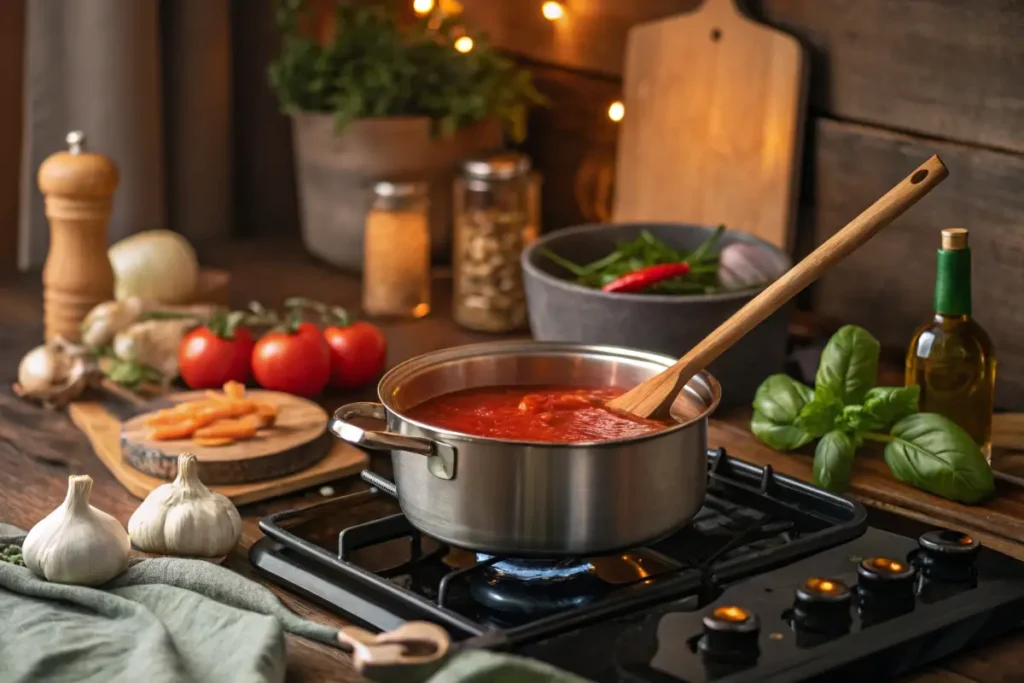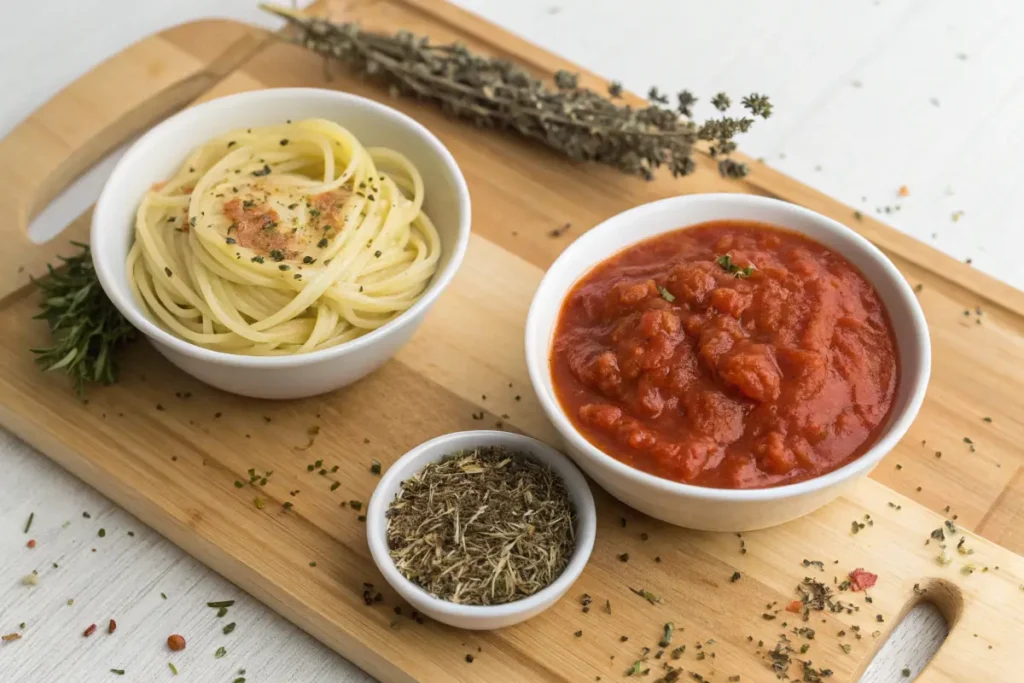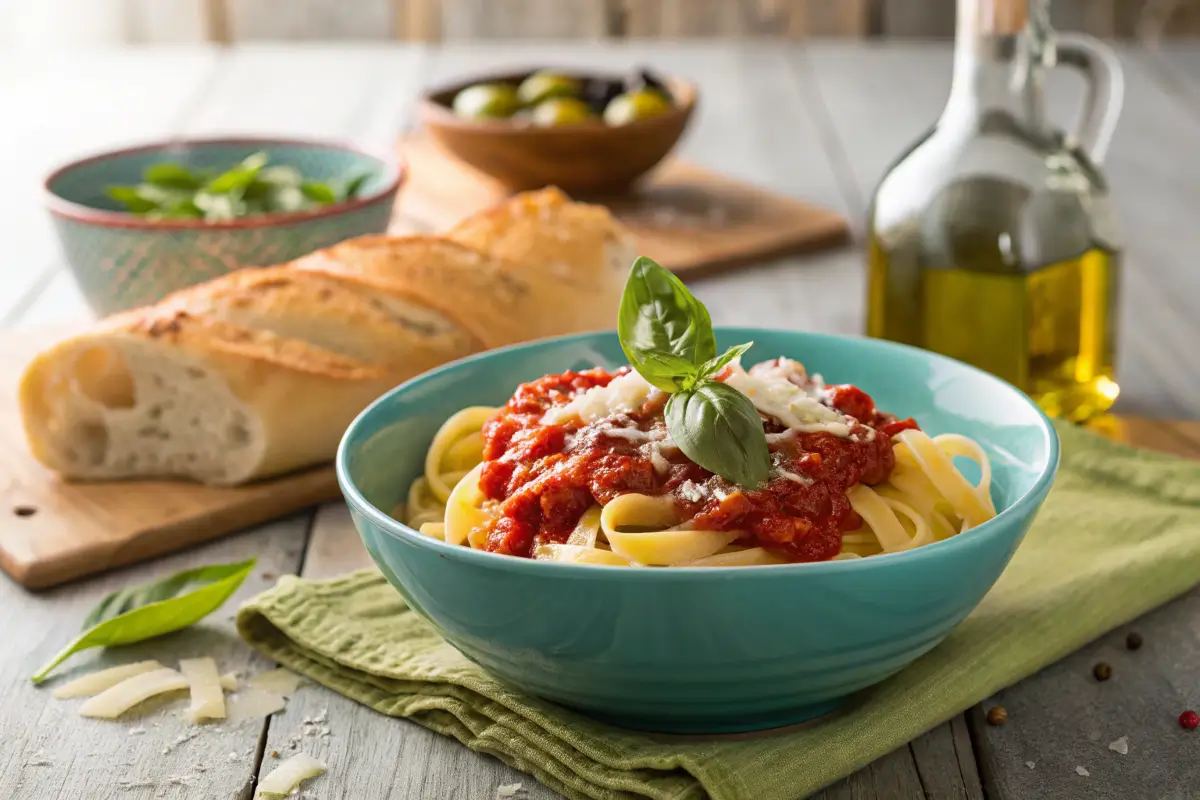When you’re craving pasta but realize you’re out of pasta sauce, you might wonder, Can I use tomato sauce instead of pasta sauce? The short answer is yes, but there’s a bit more to it. Tomato sauce and pasta sauce might look alike, but they’re not exactly the same. In this guide, we’ll break down the differences, show you how to make swaps work, and share tips for enhancing your tomato sauce for pasta perfection. Let’s dive in!
Understanding Tomato Sauce and Pasta Sauce
What is Tomato Sauce?
Tomato sauce is a kitchen staple, but what exactly is it? It’s made from pureed or crushed tomatoes and is often canned or jarred for convenience. Typically, tomato sauce contains little to no seasoning, making it a blank slate for recipes. It’s versatile and used in everything from soups and stews to casseroles and pizza bases.
Unlike pasta sauce, tomato sauce is usually thinner and simpler. Some versions include salt or sugar, but it doesn’t come pre-seasoned with the herbs and spices that give pasta sauce its signature flavor.
“Think of tomato sauce as a starting point—a plain canvas ready for your culinary creativity.”
Table of contents
- Understanding Tomato Sauce and Pasta Sauce
- Substituting Tomato Sauce for Pasta Sauce
- Tomato Sauce vs. Other Substitutes
- Enhancing Store-Bought Tomato Sauce for Pasta
- Common Questions About Using Tomato Sauce as Pasta Sauce
- FAQs
- Wrapping It Up: The Best Sauce Swap Tips
- Common Mistakes When Substituting Tomato Sauce for Pasta Sauce
- Creative Twists to Elevate Your Tomato Sauce
What is Pasta Sauce?
Pasta sauce, on the other hand, is the dressed-up sibling of tomato sauce. It’s thicker, heartier, and fully seasoned. Commonly known as marinara or spaghetti sauce, it’s packed with ingredients like garlic, onions, basil, oregano, and sometimes even meat or vegetables. The flavors are bold and ready to complement pasta dishes straight from the jar.
The main difference? Pasta sauce is designed to stand alone, while tomato sauce needs a little help to shine.
“If tomato sauce is the base of the orchestra, pasta sauce is the full symphony!”
Understanding these differences can help you decide when to swap one for the other. Next, we’ll explore how to transform tomato sauce into pasta sauce for those pasta night emergencies.
Substituting Tomato Sauce for Pasta Sauce
How to Transform Tomato Sauce into Pasta Sauce
So, can I use tomato sauce instead of pasta sauce? Absolutely, but you might need to give it a little makeover first! Tomatosauce is like the plain T-shirt of the sauce world—it’s simple and versatile but needs a little styling to stand out in a pasta dish.
Start by heating the tomato sauce in a pan. Add a splash of olive oil and sauté minced garlic and onions for added depth. Then, sprinkle in some dried herbs like basil, oregano, or Italian seasoning. Don’t forget a pinch of sugar—it balances the acidity of the tomatoes. If you like a richer flavor, stir in a dollop of tomato paste or butter. Voilà! You’ve turned plain tomatosauce into a flavorful pasta-ready topping.
When It Works (And When It Doesn’t)
Tomato sauce works perfectly as a substitute for pastasauce in most situations, especially if you’re in a pinch. It’s great for simple spaghetti nights or when you’re layering a lasagna. However, it might not hold up in recipes that require thicker sauces, like baked ziti or stuffed shells.
“If the sauce needs to cling to your pasta like a cozy sweater, stick with traditional pasta sauce or thicken your tomato sauce.”
For extra inspiration, check out this guide to making delicious homemade pasta dishes.
Tomato Sauce vs. Other Substitutes
Comparing Tomato Sauce to Canned Tomatoes
Canned tomatoes are another common pantry staple, but how do they compare to tomato sauce? First and foremost, the main difference lies in the texture. While tomato sauce is smooth and ready to use right out of the jar, canned tomatoes (whether whole, diced, or crushed) often require blending to achieve a similar consistency. Additionally, canned tomatoes usually come unseasoned, which means you’ll need to add herbs and spices to enhance their flavor.
On the bright side, when seasoned well, blended canned tomatoes can work as a fantastic alternative to both tomato sauce and pasta sauce. For example, they provide a fresh, vibrant base for your dish, especially if you want more control over the seasoning and thickness of the sauce. In short, with a bit of preparation, canned tomatoes can be just as versatile and delicious as their smoother counterpart.
Tomato Sauce vs. Tomato Paste
Tomato paste is like tomato sauce’s more intense sibling. It’s thick, concentrated, and bursting with flavor. While it’s too overpowering to use on its own, you can dilute it with water or broth to create a sauce-like consistency. Adding olive oil, garlic, and seasonings can transform tomato paste into a quick and easy pasta sauce substitute.
Enhancing Store-Bought Tomato Sauce for Pasta
Adding Herbs and Spices

So, can I use tomato sauce instead of pasta sauce? Yes, and here’s how to make it shine! Store-bought tomato sauce often lacks the bold flavors of pasta sauce, but a few tweaks can work wonders. Begin by heating the sauce on medium heat and adding your favorite dried or fresh herbs. Basil and oregano are classics, but don’t shy away from thyme or rosemary for extra depth.
For a hint of spice, toss in a pinch of red chili flakes. Craving garlic? Sauté minced garlic in olive oil before mixing it into the sauce. The possibilities are endless, and each tweak brings your sauce closer to a homemade pasta masterpiece.
“A sprinkle of seasoning transforms plain sauce into a dish you’d proudly serve guests!”
Using Additional Ingredients
Want to take things up a notch? Additions like cream, butter, or grated Parmesan cheese create a richer, velvety texture. For a chunky, rustic feel, stir in diced vegetables like onions, bell peppers, or mushrooms. Protein lovers can add browned ground beef, sausage, or even shredded chicken for a heartier sauce.
Here’s a quick reference to level up your store-bought tomato sauce:
| Add-In | Flavor Impact |
|---|---|
| Fresh Garlic | Bold, aromatic base |
| Parmesan Cheese | Creamy, salty richness |
| Red Chili Flakes | A spicy kick |
| Diced Veggies | Texture and earthy flavors |
| Fresh Herbs | A burst of freshness |
Common Questions About Using Tomato Sauce as Pasta Sauce
Is Tomato Sauce the Same as Marinara?
While tomato sauce and marinara share some similarities, they’re not exactly the same. For starters, marinara is typically seasoned with garlic, onions, and herbs, making it ready to use straight from the jar for pasta dishes. In contrast, tomato sauce is often plain and requires extra ingredients to match marinara’s flavorful profile. As a result, tomato sauce serves as a more flexible base for different recipes.
Can I Use Pizza Sauce Instead of Pasta Sauce?
Yes, but proceed with caution! Unlike pasta sauce, pizza sauce is thicker and more concentrated, designed to stick to pizza crusts without making them soggy. To make it work for pasta, dilute it slightly with water or broth to achieve the right consistency. Additionally, you might need to adjust the seasoning, as pizza sauce often has a sweeter or spicier flavor compared to pasta sauce.
What Can I Add to Tomato Sauce to Make It Taste Like Pasta Sauce?
Great question! Add olive oil, minced garlic, and Italian herbs like basil and oregano. A splash of balsamic vinegar or red wine can also bring a deeper, complex flavor.
Is Tomato Purée the Same as Tomato Sauce?
Not quite. Tomato purée is thicker and less seasoned than tomato sauce. However, it can be diluted and seasoned to work as a substitute in pasta recipes.
For more inspiration, check out this guide to cooking hearty pasta meals. It’s packed with ideas for perfect pasta nights!
FAQs
How Do I Make Tomato Sauce Thicker?
If your tomatosauce is too watery for pasta, don’t worry—there are easy fixes! Simmer the sauce on low heat without a lid, letting the liquid slowly evaporate. This method not only thickens the sauce but also concentrates its flavor. For a quicker option, stir in a spoonful of tomato paste. If you have cornstarch or flour, mix a small amount with water to create a slurry and add it to the simmering sauce.
“Thickening your tomato sauce is like giving it a hug—it helps it cling perfectly to your pasta!”
Can I Use Ketchup Instead of Tomato Sauce?
Technically, you can, but it’s not ideal. Ketchup is sweeter and less acidic than tomato sauce due to added sugar and vinegar. If you’re in a pinch, you can dilute ketchup with water and mix in some herbs to balance its flavor. However, it’s better suited for burgers than pasta.
Is Tomato Puree a Good Substitute for Pasta Sauce?
Absolutely! Tomato puree is smoother and richer than tomato sauce, making it a fantastic substitute. To use it as pasta sauce, add olive oil, garlic, and seasonings like oregano or basil. You may need to adjust the thickness by adding a splash of water or broth.
What’s the Best Way to Store Homemade Pasta Sauce?
If you’ve transformed your tomato sauce into a delicious pasta sauce, storing it is simple. Keep it in an airtight container in the fridge for up to five days. For longer storage, freeze it in portions.
“A freezer stash of homemade pasta sauce is like a gift to your future self on a busy weeknight!”
Wrapping It Up: The Best Sauce Swap Tips
So, can I use tomato sauce instead of pasta sauce? You bet! With a few tweaks, tomato sauce can easily step into the spotlight as a pasta-ready star. Whether you’re thickening it, seasoning it with fresh herbs, or adding some creamy touches, the options are endless.
The beauty of tomato sauce lies in its versatility. It’s a blank canvas, ready to transform into marinara, pizza sauce, or even a hearty base for lasagna. And if you’ve got canned tomatoes or tomato paste on hand, they’re just as adaptable.
Common Mistakes When Substituting Tomato Sauce for Pasta Sauce
Overlooking the Importance of Seasoning

One common mistake when answering the question, “Can I use tomato sauce instead of pasta sauce?”, is skipping the seasoning step. Tomato sauce is often plain and lacks the flavor punch needed for paasta. Forgetting to add basic seasonings like garlic, basil, and oregano can leave your dish tasting bland.
Always take a few minutes to sauté garlic or onions in olive oil before mixing in your tomato sauce. This simple step adds depth and a homemade touch that transforms a basic sauce into something memorable.
Not Adjusting the Consistency
Another frequent error is not paying attention to the sauce’s texture. Pasta sauce is thicker, helping it cling to the pasta for a perfect bite. Tomato sauce, on the other hand, can be too watery. Skipping the thickening process—whether through simmering, adding tomato paste, or incorporating grated cheese—can result in a runny, less satisfying dish.
“Think of consistency as the glue that holds your pasta and sauce together. A little extra effort goes a long way!”
Creative Twists to Elevate Your Tomato Sauce
Adding Unexpected Ingredients
f you’ve nailed the basics and are wondering, “Can tomato sauce be used in place of pasta sauce and still be exciting?”, the answer is absolutely! Try adding unique ingredients like a splash of red wine to deepen the flavor or a dollop of pesto for a fresh, herby twist. Craving a creamy touch? Stir in a bit of heavy cream or ricotta to create a silky, indulgent texture.
Pairing with Fresh Ingredients
Take your sauce to the next level by adding fresh ingredients. Diced tomatoes, spinach, or sautéed zucchini can make your dish more vibrant and nutritious. If you love bold flavors, throw in some capers or olives for a Mediterranean twist. These additions not only boost flavor but also make your sauce feel fresh and homemade.
With these tips, you’ll never have to wonder, “Can I use tomato sauce instead of pasta sauce?” again. A little creativity and a dash of confidence can turn even the simplest ingredients into a meal to remember!




